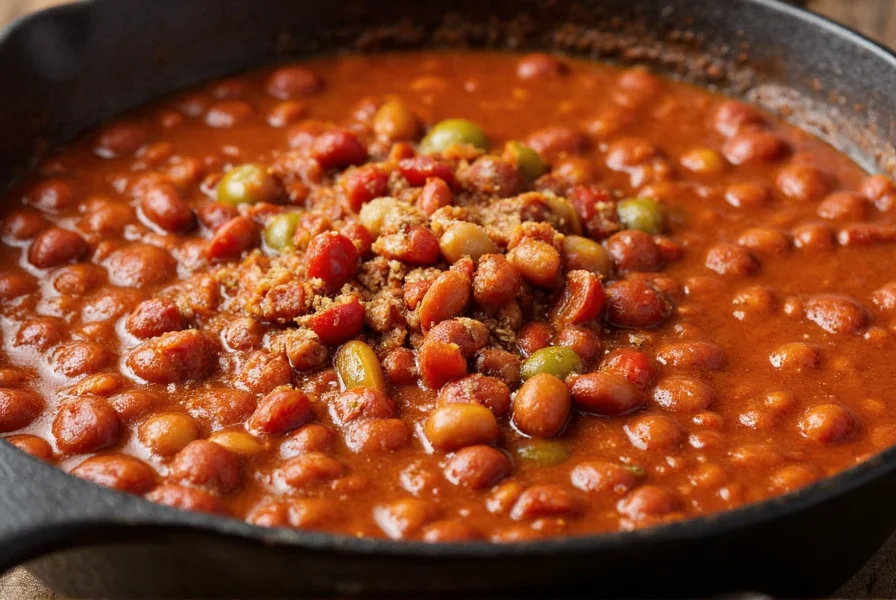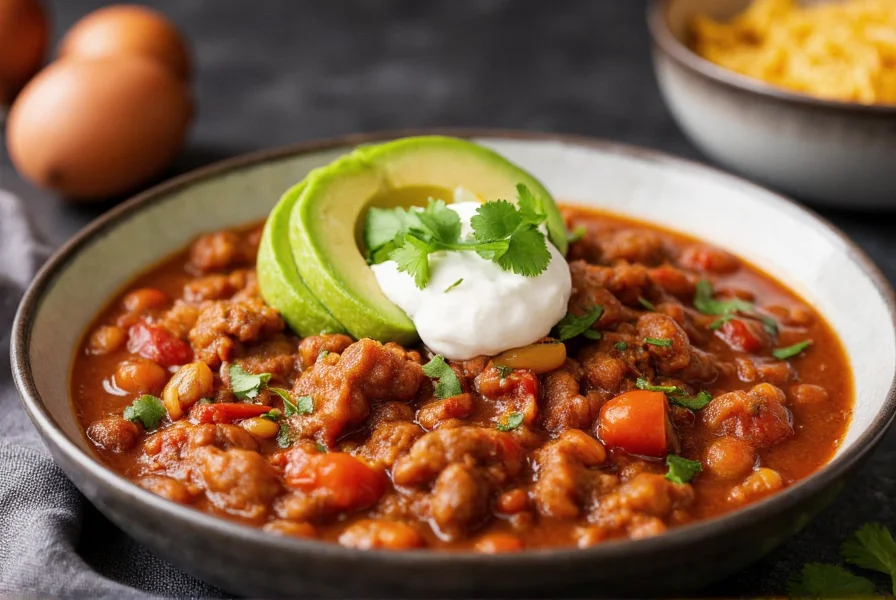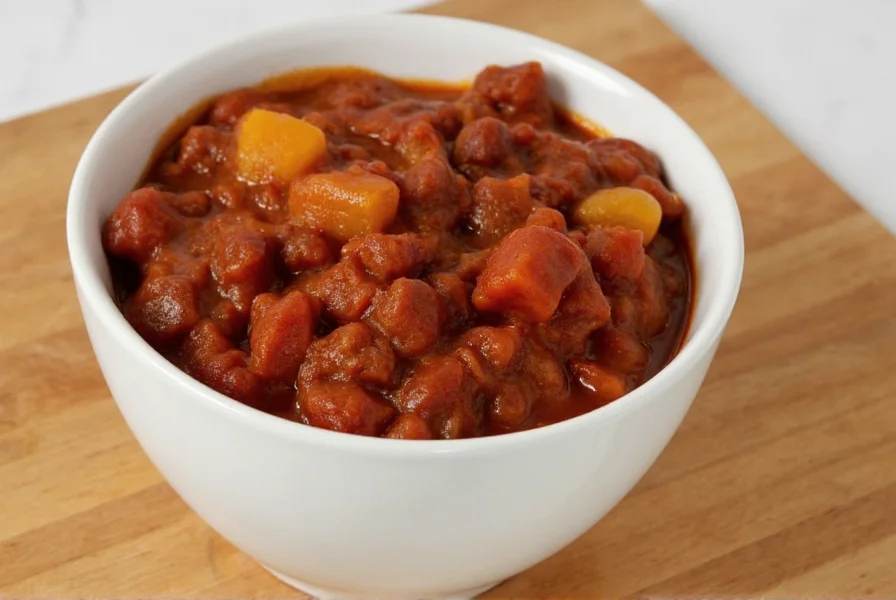Creating exceptional meatless chili requires understanding how to build flavor depth without meat. The secret lies in strategic ingredient combinations and cooking methods that develop rich umami notes. Unlike common misconceptions, meatless chili isn't simply traditional chili with the meat removed—it's a distinct culinary creation with its own flavor profile and texture requirements.
The Essential Components of Flavorful Meatless Chili
Successful meatless chili hinges on three critical elements: protein foundation, flavor base, and spice complexity. For the protein component, a blend of beans provides both texture and nutritional balance. Kidney beans offer meaty texture, black beans contribute earthiness, and pinto beans add creaminess. Consider adding textured vegetable protein (TVP) or chopped mushrooms for additional meat-like texture without compromising the vegetarian nature of your dish.

Building Flavor Without Meat
Developing deep flavor in meatless chili requires careful attention to the cooking process. Start by sautéing onions, garlic, and bell peppers until deeply caramelized—this creates the flavor foundation. Add spices like cumin, smoked paprika, and chipotle powder directly to the oil to bloom their flavors. For authentic depth, incorporate umami boosters such as tomato paste, soy sauce, or a splash of liquid smoke.
One professional technique involves using roasted vegetables. Roasting sweet potatoes, eggplant, or mushrooms before adding them to the chili concentrates their natural sugars and creates complex flavor compounds that mimic the Maillard reaction typically achieved with meat browning.
Step-by-Step Meatless Chili Preparation
Follow this method for consistently excellent results:
- Sauté diced onions, bell peppers, and garlic in olive oil until deeply caramelized (15-20 minutes)
- Add spices directly to the oil and cook for 1 minute to release essential oils
- Incorporate tomato paste and cook until it darkens slightly
- Add beans (kidney, black, and pinto), fire-roasted tomatoes, and vegetable broth
- Include roasted sweet potatoes or mushrooms for texture variation
- Simmer uncovered for 45-60 minutes to concentrate flavors
- Add finishing touches like lime juice and fresh cilantro before serving
Common Meatless Chili Mistakes to Avoid
Many home cooks encounter issues with bland or watery meatless chili. The most frequent problems include:
- Insufficient cooking time for flavor development
- Using only one type of bean, resulting in monotonous texture
- Adding spices too late in the cooking process
- Over-relying on liquid, creating a soup-like consistency
- Neglecting acid balance (a splash of vinegar or lime juice at the end brightens flavors)
Nutritional Benefits of Regular Meatless Chili Consumption
Meatless chili offers significant health advantages compared to traditional meat-based versions. A typical serving provides:
| Nutrient | Per Serving (1.5 cups) | Health Benefit |
|---|---|---|
| Dietary Fiber | 15g (54% DV) | Supports digestive health and satiety |
| Protein | 18g | Complete protein profile when beans combined with grains |
| Iron | 25% DV | Plant-based iron absorption enhanced by vitamin C in tomatoes |
| Saturated Fat | 1g | Significantly lower than meat-based chili options |
Regular consumption of bean-based dishes like meatless chili correlates with reduced risk of heart disease, improved blood sugar regulation, and better weight management. The high fiber content promotes sustained fullness, making it an excellent choice for healthy meal planning.
Variations for Different Dietary Needs
Meatless chili adapts beautifully to various dietary requirements:
- Gluten-free meatless chili: Naturally gluten-free when using certified broth and checking spice labels
- Spicy meatless chili variations: Add chipotle peppers in adobo or cayenne pepper for heat
- Slow cooker meatless chili instructions: Brown vegetables first, then transfer to slow cooker for 6-8 hours on low
- Instant Pot meatless chili: Use sauté function for vegetables, then pressure cook for 15 minutes

Serving and Storage Recommendations
Meatless chili often tastes better the next day as flavors continue to meld. For optimal results, refrigerate overnight before serving. When reheating, add a small amount of broth or water to restore ideal consistency.
For meal prep enthusiasts, meatless chili freezes exceptionally well for up to three months. Portion into individual containers for convenient healthy lunches. The best toppings enhance both flavor and nutritional profile—consider avocado for healthy fats, Greek yogurt instead of sour cream for added protein, and fresh lime juice to brighten flavors.
Frequently Asked Questions
How can I make meatless chili taste more like traditional chili?
Achieve meat-like depth by incorporating umami-rich ingredients: use smoked paprika, a tablespoon of soy sauce or tamari, roasted mushrooms, and a small amount of instant coffee. Browning your vegetables thoroughly before adding liquids creates complex flavor compounds similar to the Maillard reaction from browning meat.
What's the best bean combination for meatless chili?
The ideal combination includes kidney beans for texture, black beans for earthiness, and pinto beans for creaminess. For additional protein variation, consider adding cannellini beans or chickpeas. Using three different beans creates textural interest that prevents the chili from becoming monotonous.
Can meatless chili be high in protein without meat?
Absolutely. A single serving of properly prepared meatless chili typically contains 15-18 grams of complete protein when combining different beans. Adding quinoa or textured vegetable protein (TVP) can boost protein content further. The protein in beans is accompanied by fiber and complex carbohydrates, creating a more balanced nutritional profile than meat-based protein sources.
How long should meatless chili simmer for best flavor?
For optimal flavor development, simmer meatless chili uncovered for 45-60 minutes after all ingredients are combined. This allows flavors to meld while concentrating the liquid. Unlike meat-based chili, you don't need extended cooking times for tenderizing meat, but the simmering process is crucial for developing complex flavor layers from the vegetables and spices.
Is meatless chili suitable for meal prep and freezing?
Meatless chili is excellent for meal prep and freezes exceptionally well for up to three months. The flavors often improve after freezing and thawing. For best results, cool completely before portioning into airtight containers, leaving one inch of headspace for expansion. Thaw in the refrigerator overnight and reheat gently with a splash of broth to restore ideal consistency.











 浙公网安备
33010002000092号
浙公网安备
33010002000092号 浙B2-20120091-4
浙B2-20120091-4